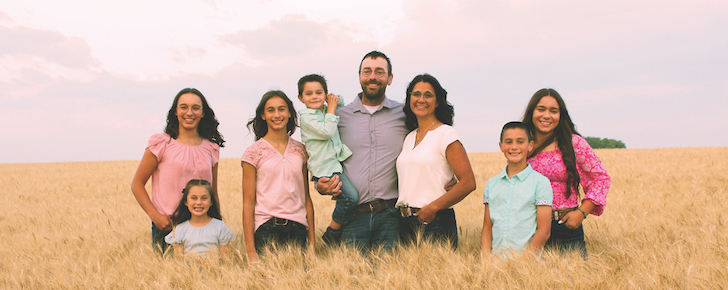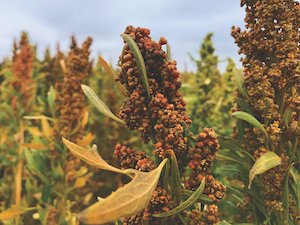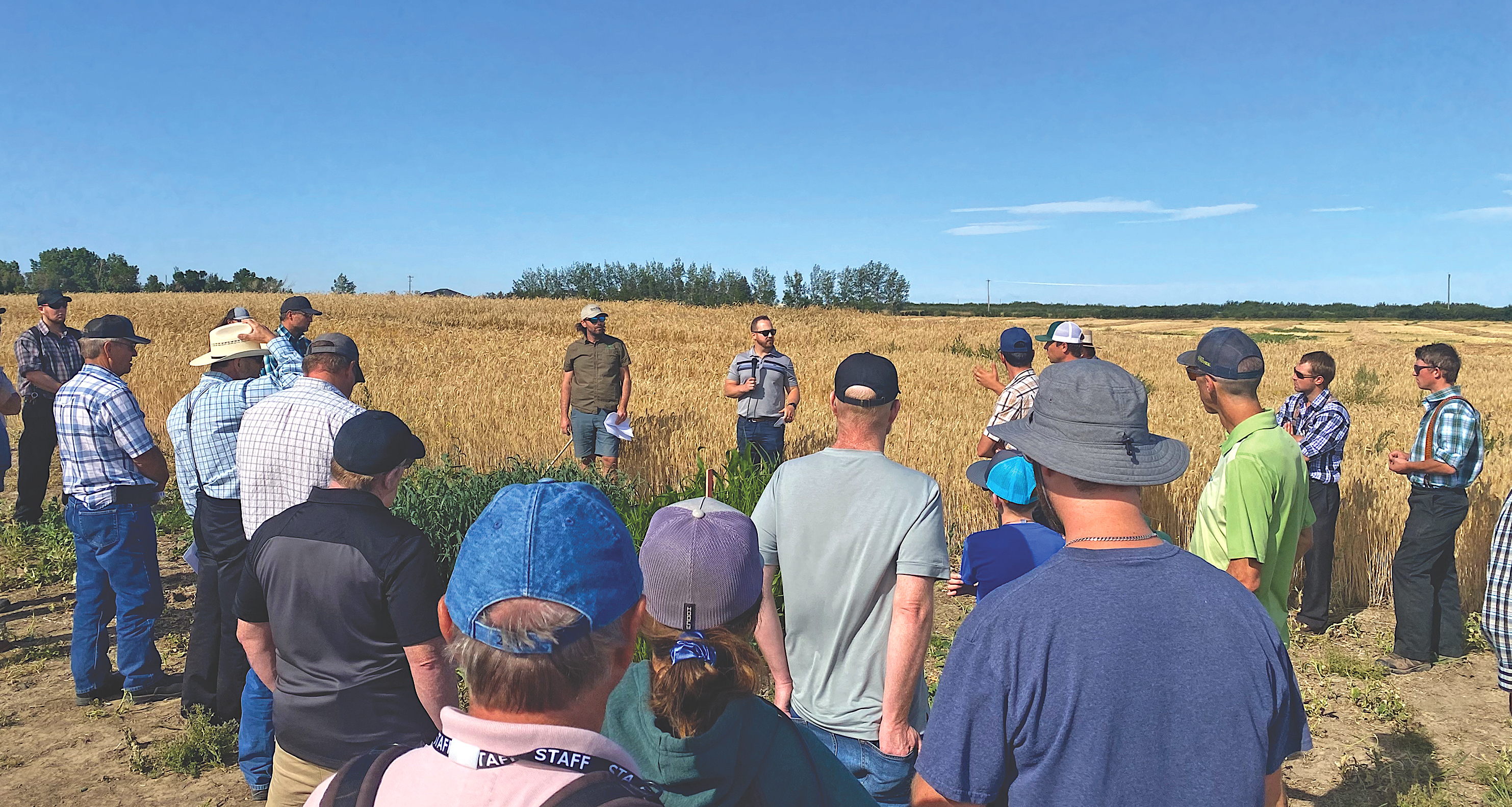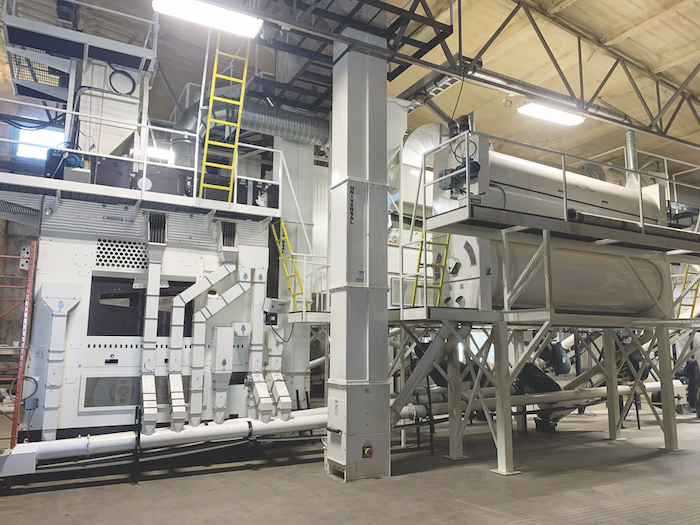
By Treena Hein
When striving for a goal it’s often wise to put a time limit on the endeavour. Give it your best shot within a given period of time, and if it fails, it fails. With a little luck and hard work however, it just may succeed.
For Greg and Sarah Stamp, that goal was to farm full time within five years. They started working with Greg’s parents in 2006 at the family farm in Enchant, AB, a hamlet located about 150 km southeast of Calgary. Those five years were very tough indeed, but they achieved their goal and today are valuable contributors to Canada’s pedigreed seed industry.
For their hard work building the business, which not only supports their family but those of Greg’s brothers Nathan and Matthew, Greg and Sarah won the 2023 Outstanding Young Farmers Program award for the Alberta/NWT region and were also co-winners of the program’s national award.
BUILDING A FAMILY BUSINESS

Aerial view of Stamp Seeds operation.
It was the late 1980s when Greg’s parents, Richard and Marian, started growing a limited quantity of pedigreed seed. “They got a lot of mentorship from the big players but, due to a few factors, their seed business was inactive by the early 2000s,” Greg explains. “Sarah and I talked with them and came back in 2006 as employees. We helped with the cropping and started reviving the seed business.”
The five-year time frame Greg and Sarah set for themselves was far from easy — three of those years saw hail and low commodity prices and the farm was small at only 500 acres. But they soldiered on, invested in equipment and, in year four (2010), decided to purchase a 20 per cent stake in the farm. “Once you’re in farming, you don’t want to leave,” says Greg. “And we could see the opportunity, we could see the light at the end of the tunnel, and we were all in.”

Quinoa
Richard had always advocated early succession planning, so pretty much from year one, he and Sarah dug into the transition process, using the help of several professionals. They looked carefully at how Nathan and Matthew could join the farm business, which they both did in 2010, and focused heavily on business operations because, for them, who owned what asset was a secondary concern.
On that first 500 acres, they grew commodity crops and revived the seed production business by growing under contract for other seed growers. Although the returns were modest, they decided early on to start growing pedigreed seed themselves to supply the big seed firms.
They also sold seed directly to farmers. As it turns out, Greg is a natural at sales. “I was surprised that I really like sales and marketing,” he says. “I like that you can offer other farmers something that’s better than what they have, that’s going to be great for their farm.” While Greg focused on that, Nathan eventually took on farm management, and Matthew, business operations.

Stamp Seeds hosts summer and fall crop tours, which gives its customers a chance to see how a pedigreed seed operation works and to ask questions.
EXPANSION AND CUSTOMER ENGAGEMENT
Now with their goal of farming full time a reality, the Stamps turned their attention to expansion and customer engagement. Around 2013, the Stamps decided to start field-scale variety comparison trials. Greg says this helped them learn a huge amount about the varieties they wanted to grow, and customers also loved the first-hand knowledge. They started to hold summer and fall crop tours and invested in building the digital side of the business including creating a massive website. Questions and comments from customer emails turned into blog entries and YouTube videos. It wasn’t just about varieties, but about agronomy.
In 2014, they bought their uncle’s farm (absorbing his seed business) along with other farms in the area, setting the Stamps up for massive growth, starting the following year. They set a goal to produce seed at volumes that would keep their own cleaning facility busy because they felt that relying on other facilities was holding them back in terms of timelines and logistics. They had started buying cleaning equipment in 2016 and by 2021, had enough to handle their entire operation.
They also continued to develop their customer outreach. “We added a customer newsletter, and Twitter was phenomenal for sharing new varieties,” says Greg. “We did a lot of events. It was a two-way street because we always learned a lot from our customers and still do. We turned into a resource for agronomic advice.”
He says that working with Farming Smarter, Alberta Barley Commission and other farm groups was a big help in this effort. “You learn so much being involved in these organizations, from the bigger picture down to how people do things differently on their own farm,” says Greg. “Hopefully you are also contributing to the next generation.
“We’re also part owners of SeedNet and have learned a lot with that,” he says. SeedNet was created in 2010 by 14 independent seed growers to pool knowledge and provide farmers with the highest quality seed available. Today, SeedNet has over 40 seed retailers across the Prairies. “Yes, we are (competitors), but we work with them on varieties and opportunities, and everyone wins.”

Inside Stamp Seeds seed cleaning plant.
EMBRACING RISK AND LOOKING FORWARD
Stamp Seeds’ equipment is now all automated. The operation also uses seed management software called Seedtrackr, to track all seeds along their planting, harvest and processing journey. It is a sign of the incredible growth and success the Stamps have achieved in the mere 13 years since buying a stake in the family farm.
Today, Stamp Seeds has 19 full-time plus seasonal employees, and operates on 7,000 acres (about half of which is rented) and has irrigation on 5,000 of those acres. “We’d like to be all irrigated,” says Greg. “We are fortunate to be in (an irrigation) district where we have more stream diversion and storage than others, but there are concerns over water levels, even in our district, if we get less snowpack for two or more years. So, we hope for lots of snow ever year.” He says that the region’s long growing seasons and dry autumns are also ideal for growing high quality pedigreed seed.
Greg reflects back on his and Sarah’s 2010 decision to buy a stake in the family farm. “We took a lot of risk buying land, renting land, buying better bins for shipping, buying three seed treaters, the cleaning equipment — but it’s all paid off,” says Greg. “We were lucky that ag has had a good 10 years, but we didn’t know that at the time.”
But success is more than luck. “I think it was our agronomic support and the variety of choices we offered that really supported our success,” says Greg. “We grew different types of wheat, hard white and winter wheats, yellow flax in addition to brown. We started early with faba beans and hybrid rye, at the ground floor.” Still, he says, “sometimes it’s hard to believe we sell seed across Canada.”
Always looking ahead, Stamp Seeds is currently focused on growing the seed production management side of the business — handling the entire production process for customers — which it has already done successfully on a small scale. Richard is still active with recruitment and special projects and Marian steps in as needed. “I feel very fortunate that we had the opportunity to learn from them from a young age,” says Greg. “They’re very pleased with our success and we are hoping to learn from them for many more years.”